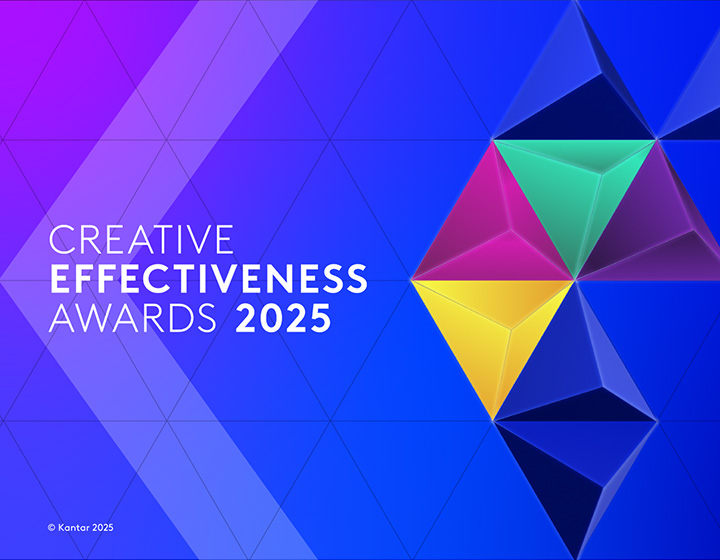Brands are seriously funny things. On the one hand, this is a golden age for brands: we’ve never had as much knowledge demonstrating the competitive advantage they deliver to businesses in the short and longer term. And, thanks to the work from Ehrenberg Bass Institute, hard evidence of the importance of reach and saliency in driving growth from sales penetration.
Yet the uncomfortable truth is that these pre-existing models of growth are still insufficient to explain the full contribution brands make to the bottom line, or how to deliver that in practice. Because:
- in a digitally connected economy, transformational brand value can be built differently through experience and innovation
- sales response to advertising is half of what it was
- recently inflation has exposed and amplified the critical importance of pricing power and margin as a commercial lever that successful brands deploy, alongside sales volume
So, it’s time to think differently.
Kantar BrandZ Breakthrough Brand analysis
BrandZ is Kantar’s brand valuation engine of over 21,000 brands in 52 markets based on 4.2 million consumer interviews. It puts a value on the commercial contribution of brand equity. This is fuelled by three core values for brands:Meaningful: relevantly meeting functional and emotional needs in a category
Different: a combination of being seen as unique and leading the way
Salient: coming to mind easily when making a choice between brands
For one of our presentations at Cannes Lions 2023, we put this extraordinary dataset to the test in two ways to help us reframe the commercial contribution brands make in the connected economy.
1. In a pioneering study we partnered with the Saïd Business School at the University of Oxford to model which brand equity factors are most critical in delivering ‘abnormal’ share price returns – and interrogated the relative importance of those factors.
2. We used BrandZ data to identify global ‘Breakthrough Brands’ – brands that have grown most rapidly in terms of brand value in recent years – and what sets them apart from the rest.
Together, these analyses reveal new insight into how brands maximise commercial returns, and which strategic levers to focus on to maximise impact.
Difference makes the difference
To analyse the contribution of brand equity on share price growth, Oxford University’s Saïd Business School built a sophisticated model based on financial results from 872 brands between 2006-2022 across multiple categories, to understand the contribution of Kantar BrandZ’s equity measures to share price outperformance. The model including brand equity variables had over 99% accuracy, a major advance compared with models using just financial data.
This work showed three things.
1. Difference is the No. 1 brand factor on share outperformance (Corporate Responsibility was third)
2. It accounts for 35% of brand impact on outperformance, salience was just 0.6%
3. The importance of difference is increasing over time and salience is decreasing
This evidence exposes as false the assertion that difference doesn’t exist between brands or matter much. Consumers do perceive it, and it is the factor that matters most in driving share price outperformance.
Difference is the most important brand factor on share price outperformance
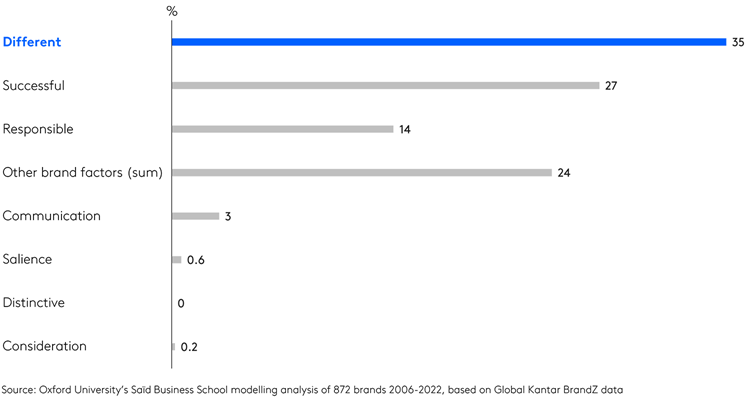
How difference makes the difference
So, these are not small start-ups. They’re bigger brands that demonstrate dynamic ‘breakthrough’ growth momentum, that lead the way for others to follow. This analysis shines a light on the factors that matter most in unlocking a brand’s full commercial impact on the bottom.
The analysis shows any brand can be a ‘breakthrough brand’. They come from every category and every kind of maturity. Examples include KFC, Chipotle, Lululemon, Tesla, Aldi, Uniqlo, TikTok and Airbnb as well as Kantar BrandZ’s No. 1 most valuable global brand Apple.
So what makes these brands different?
In a word: Difference. They are seen – and experienced – as being different enough from competitors. Difference is the rocket fuel powering their extraordinary growth, also debated in our recent interview with Mark Ritson, Mini-MBA professor and Marketing Week columnist, once is less of a factor for them.
Breakthrough brands are hardwire for difference
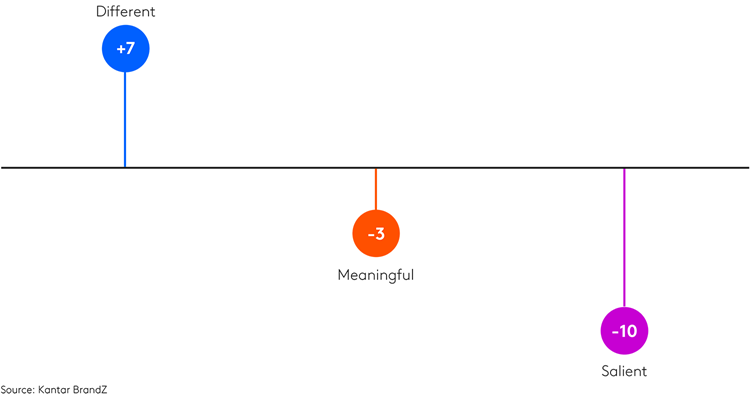
We see the ‘true’ power of difference by stripping out the effect of brand size. We analysed the Kantar BrandZ database identifying brands that grew market share over a 3-4 year period, comparing their starting equity position relative to brand size with the net chance of gaining share. This highlighted the factors underpinning their growth beyond what would have been expected given their size: what we’ve called the ‘excess’ level.
The analysis shows brands with ‘excess’ Meaning or Salient had only small chances of growth. In contrast, starting with ‘excess’ different turbocharged their growth potential. And their growth potential increased the stronger the excess difference.
Relative ‘Excess’ difference drives the strongest growth
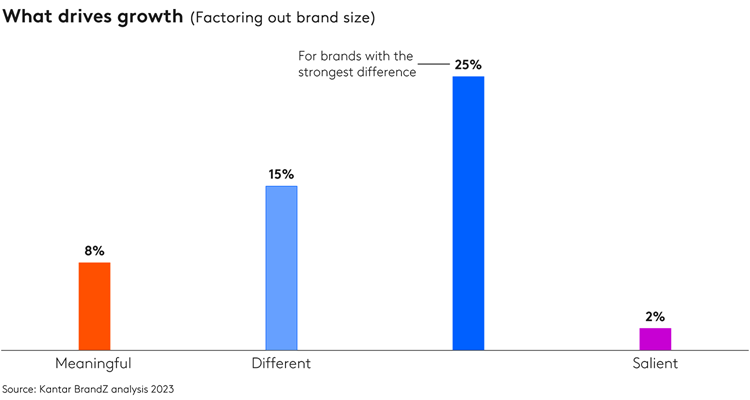
Critically, our analysis also shows why difference is so key to share return outperformance: because it is key to building perceptions of being ‘worth paying more for’. This in turn strengthens a brand’s competitive price power and margin. In fact, different is the leading driver of Pricing Power in many categories - on average Meaningful and Different together account for 94% of Pricing Power, and salient just 6%.
This creates a huge commercial growth advantage as Pricing Power flows directly to the bottom line: McKinsey reports that a 1% increase in price improves operating profits by 8% - three times the boost to profits generated by a 1% increase in volume sales.
Meaningful Difference is also a stronger factor than saliency driving the pipeline for future sales too, building a protective cashflow around a brand where profits can be more deeply and consistently reinvested back into the business. This dynamic can be summarised in a brand value chain: Demand Power (sales volume) is driven by meaningful salience, Pricing Power (sales value/margin) is driven by Meaningful Difference.
The implication here is that mental and physical availability, while important, is not enough. To fully unlock a brand’s commercial growth requires doubling down on creating a perceived difference, which strengthens pricing power and margin potential - and that’s never been more important for success than now in inflationary times.
But how does this work in practice?
Factor analysis on the levers of difference highlights how it’s created by the sum of tangible and intangible factors which connect to forge brand memories. Distinctive brand assets (colours, fonts, slogans, characters, etc.) certainly play a role, accounting for 30% of difference. But the vast majority – over 70% of difference - is made from other intangible factors including positioning, product experience, service design, advertising associations, range relevance and responsibility.
The DNA of difference: distinctive assets are not enough
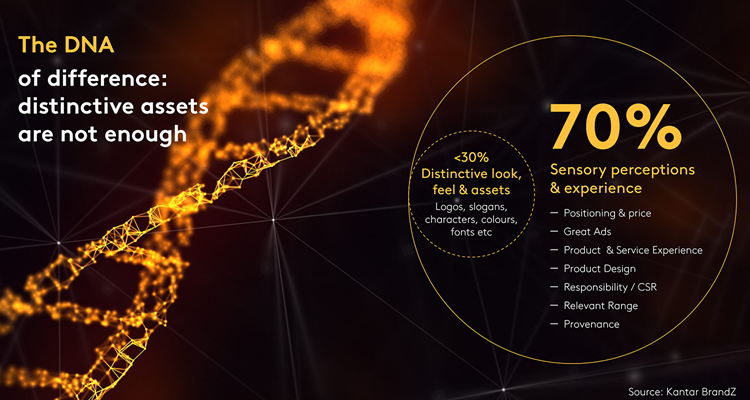
Each of these factors stimulate sensory connections in the mind, enhancing brand predisposition. This primes people to buy, pay a premium, enjoy the experience more and be less likely to leave for competitors. The implication here is that consistent use of Distinctive Brand Assets, while valuable, is not enough either.
As Jeremy Bullmore put it ‘brands are built as birds build nests, from the scraps and straws they chance upon’. In other words, they are built through emotional not just visual consistency – everything a brand does, communicates implicitly or explicitly at some level. Together, these create a sense of ‘betterness’ and quality brand leader.
Our analysis of Breakthrough Brands shows how this is achieved in practice, by designing for difference. Their growth momentum is born from a restless creative leadership style. They are more likely to be seen to be ‘shaking things up’, as creative and as having strong momentum.
‘Breakthrough Brand’ leaders frequently describe a common approach. They start with a clear compelling position, amplify it with powerful emotive communications and reinforce it through meaningfully differentiated innovation and product/service experiences.
Contrary to being ‘meaninglessly distinctive’ as Byron Sharp puts it, they are deeply purposeful in designing meaningful difference into every marketing activity. Two examples illustrate this. Firstly, Apple. BrandZ’s biggest brand in the world has twice the level of difference of other brands.
Apple’s perception as Different is created by not only great emotive advertising, but also by a unique retail experience, and consistently powerful innovations both on its flagship iPhone beyond, and AirPod Pro, which connect to each other as an ecosystem adding utility for users.
Clarity and consistency
A very different example is Cadbury, a confectionery brand with strong all-round equity including ‘excess’ difference of +5. The foundation of their success through working with Kantar has been defining a powerful emotively competitive brand territory – Generosity – which has then been expressed consistently over 5 years in their communication platform that ‘there’s a glass and a half inside everyone’.This clarity and consistency has provided a powerful backbone for applying the emotive magic of creativity, winning Kantar’s Christmas campaign of the year 2022 with ‘Secret Santa’ where it used its advertising as a platform for gifting people you love a chocolate bar. It was also a contributing factor in winning IPA Effectiveness Grand Prix 2022 for business returns it delivered.
Storydoing, rather than storytelling if you will. Zigging when others zag.
“Do what others aren’t doing & keep doing it consistently”
Jonny McCarthy, Global Head of Brand, Cadbury
Think differently about brand growth
So, our three key learnings from the analysis are:1. Mental and Physical availability is not enough. Difference makes the difference, especially to price power and to share price
2. Distinctive Brand Assets are also not enough. It’s important to design for difference by unlocking the power of creativity in every possible way as Breakthrough Brands like Apple and Cadburys do – through your strategy, communications, experience and innovation
3. Focus on your relative excess difference vs. competitors – the stronger it is, the stronger your brands’ competitive edge will be
Read more inspiration from Cannes Lions 2023 below and get in touch to find out more about our analysis and breakthrough brand growth.



